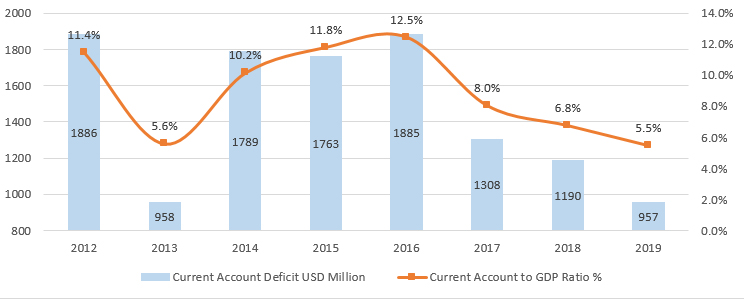Ivane Machavariani: “Our economy demonstrated high-level qualitative progress, including important parameters such as the trade balance and the current account deficit which decreased more than twofold.”
Verdict: FactCheck concludes that Ivane Machavariani’s statement is HALF TRUE.
Resume: The Minister of Finance’s statement is inaccurate in the trade balance aspect. Although export has been growing in the past years, imports have also been rising annually which resulted in the trade deficit fluctuating within the margin of USD 5.1 billion to USD 5.9 billion in 2012-2019. According to 2019’s data, the export of goods amounted to USD 3.8 billion whilst the value of import was USD 9.5 billion. In the same year, the trade deficit reached USD 5.7 billion which is higher in absolute numbers as compared to the deficit in 2015, 2016 and 2017. The gross domestic product (GDP) to the trade deficit ratio was lower in 2013, 2014 and 2017. Therefore, speaking about successes achieved in the past years is groundless.
The current account deficit in 2019 was 5.5% which is the best indicator in history whilst the deficit was fluctuating around 10% in 2015-2018. An important factor contributing to the decrease of the current account deficit in the last year was the growth in service revenues which naturally was associated with the growing tourism industry. Of additional note is that remittances also increase annually. It is, however, unclear what the Minister of Finance meant when he referred to qualitative progress. This is something which cannot be measured based on a universally accepted objective criterion. Therefore, it is impossible to verify this particular part of the statement although questions may arise in regard to the claim.
Analysis
The Minister of Finance of Georgia, Ivane Machavariani, stated: “Our economy demonstrated high-level qualitative progress, including important parameters such as the trade balance and the current account deficit which decreased more than twofold.”
Historically speaking, import has always exceeded export in Georgia which to a certain extent puts the country’s economy in a vulnerable position, especially amid the sharp fluctuation of the national currency’s exchange rate. The conjectural weakness of the Georgian economy is further indicated by the fact that Georgia’s main export groups largely consist of raw materials (copper ore and ferroalloys) whilst car export is in fact a re-export. Although export has been growing in the past years, imports have also been rising annually. As a result, the trade deficit in 2012-2019; that is, the difference between export and import, has not reduced significantly and fluctuated within the margin of USD 5.1 billion to USD 5.9 billion. According to 2019’s data, the export of goods amounted to USD 3.8 billion whilst the value of import was USD 9.5 billion. Therefore, the trade deficit in the same year reached USD 5.7 billion which is higher in absolute numbers as compared to the deficit in 2015, 2016 and 2017. If measured as the GDP to the trade deficit ratio, the trade imbalance was lower in 2013, 2014 and 2017.
Table 1: Foreign Trade Statistics in 2012-2020* (January-November Data), USD Million

Source: National Statistics Office of Georgia
In accordance with January-November’s data of 2020, the export of goods amounted to USD 3 billion, imports amounted to USD 7.2 billion and the trade balance was USD 4.2 billion. As compared to the same period of the previous year, export decreased by 11%, from USD 3.4 billion to USD 3 billion. Import decreased by 15.9% from USD 8.5 billion to USD 7.1 billion whilst the trade deficit shrank by 19% from USD 5.1 billion to USD 4.2 billion. Naturally, all things being equal, the reduction of the trade deficit is a positive thing. However, the deficit was reduced as a result of the pandemic-induced economic crisis and claiming that this reduction is qualitative progress lacks substance. First and foremost, this “progress” was the outcome of more of a decrease in import than a decrease in export. At the same time, the reduction of both import and export was stipulated by undoubtedly negative economic factors such as border closures, the universal lockdown, the limiting of economic activities as well as economic, fiscal and monetary oscillation and uncertainty, etc.
A country’s balance of payments includes comprehensive data about money inflows and outflows. The balance of payment illustrates the movement of money to a certain extent between the economy of a specific country and the rest of the world. A country’s balance of payments consists of its current account, its capital account and its financial account. A current account includes the component of trading with goods and services as well as incomes and transfers. In turn, the income component shows the inflows of income from abroad (specifically, labour remuneration and investment income) and incomes transferred from a country. Transfers include current transfers between the residents[1] and non-residents of a country (for instance grants, financial assistance).
Graph 1: Current Account Deficit in 2012-2019

Source: National Bank of Georgia
The current account deficit in 2019 was 5.5% which is the best indicator in history. Table 2 demonstrates the current account deficit structure. In accordance with the data of the first three quarters of 2020 which are already available, the current account deficit is USD 1.4 billion which is significantly higher as compared to the figure of the same period of the previous year.
Table 2: Current Account Deficit Structure in 2012-2020* (First Three Quarters), USD Million

Source: National Bank of Georgia
The growth in service revenues largely associated with the growing tourism industry is an important factor which has been contributing to the decrease of the current account deficit in the past years. Of additional note is that remittances also increase annually. It is unclear what the Minister of Finance meant in terms of qualitative progress vis-à-vis the current account deficit and, therefore, it is impossible to verify this particular part of the statement.
[1]An individual who actually resided on the territory of Georgia for more than 182 days in any 12-month period at the end of a tax year or if he has been in the public service of Georgia abroad during the course of a tax year.








